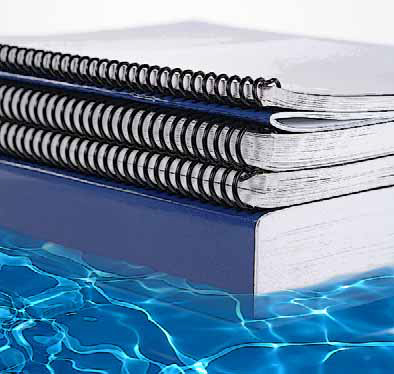column
In my last “Currents” column (June 2009), I began a discussion of Project Manuals with an overview of these written specifications and other construction documents and how they are formally bound and made part of a project’s contract documents. This time, we’ll dig inside the manuals and take a closer look at what they contain. Let me start with a simple recommendation: If you don’t already work with Project Manuals in some form, now is probably a good time to get started – especially if you’re a watershaper who prepares designs to be
In my capacity as landscape consultant to a town near where I live, I was approached recently by a landscape architect who was just starting her career after graduating from a prestigious, five-year landscape architecture program in my home state of New York. She was designing a butterfly garden, she said, and wanted to know what plants to use. As I ran down the list, she asked me to stop at one name in particular and spell it. The plant in question was
One of the themes I’ve covered repeatedly through the years has had to do with the need for all of us to become effective team players. True, there have been times when egos have gotten in the way and I’ve found myself in fairly dysfunctional groups, but for all that, I have to say that collaboration very often yields great results. In fact, the vast majority of team projects in which I get involved these days are wonderful collaborations among clients, architects and general contractors as well as (depending on the project) interior designers, landscape architects, lighting designers and more. Of all those practitioners,
I’m always surprised when I run into clients or prospects who don’t appreciate or fully accept the fact that landscape-lighting systems require routine maintenance. These are people who easily recognize the need for upkeep when it comes to their swimming pools or landscapes, but this perception simply doesn’t extend to the lighting systems that frequently go along with them. I suspect this is so because dealing with lighting inside a home is so simple – basically just a matter of changing burned out bulbs as the need arises. Some also believe that landscape light bulbs should and will last forever, which is
I must say that I look forward to receiving my own copy of WaterShapes in the mail each month. It’s not because I can’t wait to see my own columns in print; rather, it’s because so I’m amazed and inspired by the work watershapers put on display here that I always devour each and every page. That’s not, by the way, anything I’d say about the rest of the 30-odd trade magazines I receive via mail or e-mail. WaterShapes always seems to deal with the best of the best, and reading about how these incredible projects come together is
The notion that we should do all we can to exceed client expectations is one we hear trumpeted in almost every inspirational business seminar and in nearly every keynote speech during trade shows. There are very good reasons for this: After all, when you perform beyond your clients’ expectations, they’re far more likely to be pleased with the process, more reasonable in their requests and, ultimately, readier sources of the referrals that will keep your business hopping. Not only that, but there’s also something wonderful in making people happy – if for no other reason than in doing so, we tend to make ourselves happy as well. In the watershaping world, conjuring those good vibrations is right up there for me alongside
“I’m mad as hell, and I’m not going to take it anymore.” Those words (originally uttered by the fictional newsman Howard Beale, for those of you who remember the movie “Network”) reflected the frustration of a man overwhelmed by the forces that governed his working life and the society in which he lived. His declaration became the rallying cry of a movement that formed around his sense of outrage. I’m in that same sort of outraged mode right now and find myself on a similar quest for allies: I want the watershaping industry to change now and for the better, but
In recent weeks, I’ve spent a good bit of time speaking to landscaping colleagues, garden clubs and symposium attendees about our general need to get smarter when it comes to how we think about landscapes. This is all part of my perpetual campaign to convince everyone to use the right plants in the right places in order to save water, labor and the fuels consumed in maintaining them. A big part of my pitch is one I’ve addressed before in this space – that is, I object to
This past April, my wife Gina and I spent two wonderful weeks in Hawaii. As is true of most of those who visit our 50th state, we were mainly there to relax and enjoy warm weather, tropical Pacific waters, breathtaking scenery, fine cuisine and laid-back Hawaiian culture. As has been the case for countless others who’ve been there, we were not disappointed: Hawaii is everything people have said it is and much, much more. As a watershape designer, I had the added pleasure of being able to study a huge number of waterfalls and streams that mark many of the islands’ most appealing landscapes, particularly on Maui and Kauai. It was one of those happy situations where
Through the past year and a half, I’ve dedicated four “Currents” columns to the subject of drawing practices and the National CAD Standards. But construction documents consist not only of drawings, but also written specifications – so now I’ll shift my attention to Project Manuals – key communication tools used by architects and engineers to uphold quality and establish performance requirements for all of a given project’s contractors. Basically, a Project Manual is a bound book of construction documents prepared to define




















